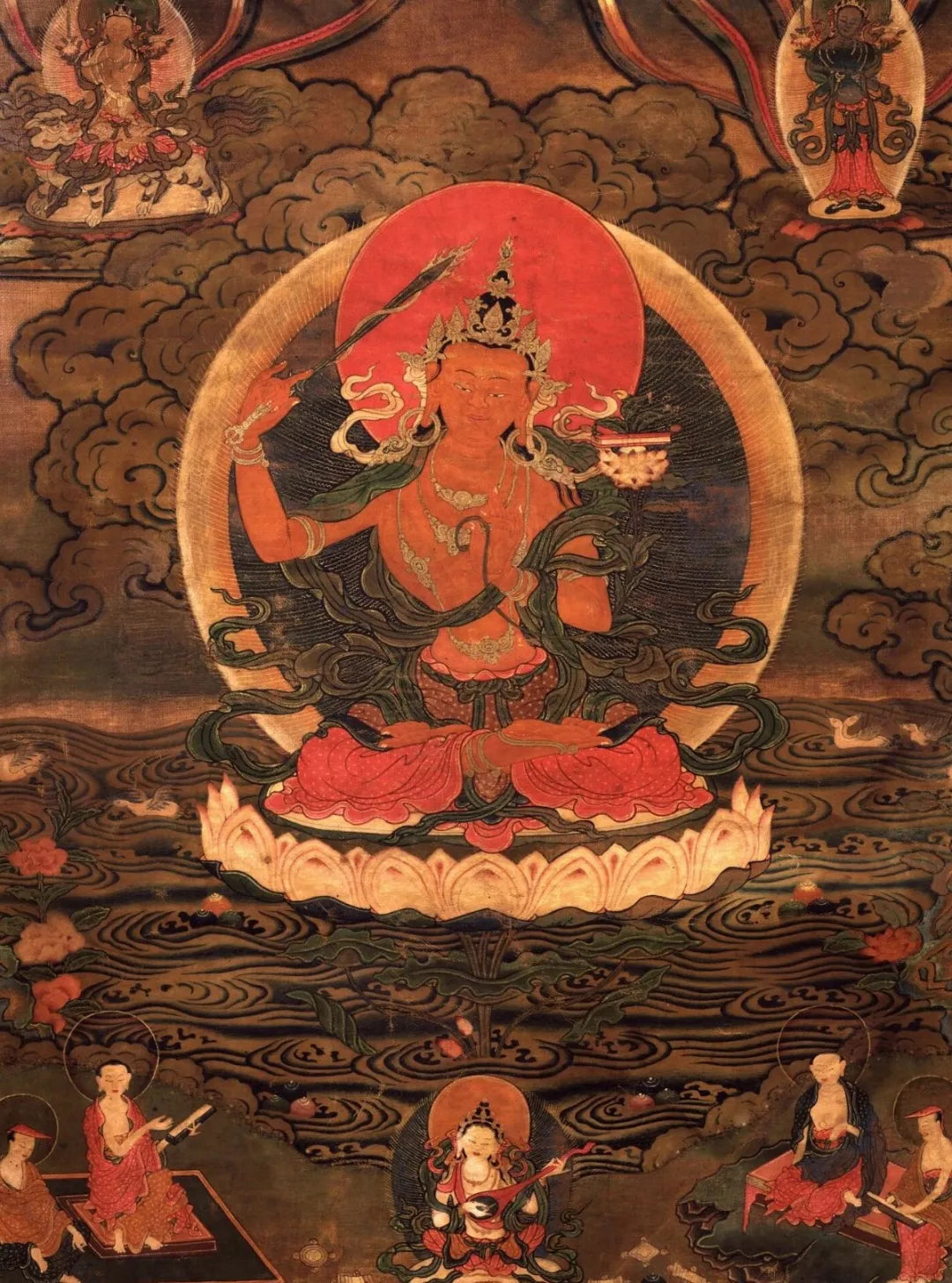
Tibetan Fragrance Journey: The World of Saffron

"The Inherent Speech of the Three Bodies of Manjushri and Various Patriarchs"
Mid-19th Century, Collection of the Rubin Museum of Art
In the color theory of Tibetan culture, there are two hues associated with saffron: saffron yellow and saffron red (གུར་གུམ་སེར་མདོག་དང་དམར་མདོག་), which can be roughly understood as a yellowish-brown and an orange-red. These colors are commonly seen in the depiction of Manjushri's bodily hue and in the robes of monastic orders (འཇམ་དབྱངས་མདོག་ཅན་). The use of saffron as a pigment has a long-standing history.

"Blue Beryl Medical Thangka: The Essence of Earth and Wood, and Medicinal Herbs of the Plains"
Early 20th Century, Lhasa Men-Tsee-Khang Collection
Detail: Saffron from Kashmir
དྲི་ཞིམ་པོ་བརྗོད་ལས་འདས་པ། རོལ་མོ་སྣ་ཚོགས་ཀྱི་སྒྲ་སྒྲོགས་པ།
ནམ་མཁའ་ནས་ལྷ་མོ་རྣམས་ཀྱིས་གདུགས་དང་
རྒྱལ་མཚན་བ་དན་བསྒྲེང་ཞིང་
གུར་གུམ་སོགས་ཀྱི་ཆར་འབེབ་པ།
གུར་གུམ་ནི་ཕྲིན་ལས་དང་སྤྱོད་པའི་རྟགས་གོ།
The fragrance is beyond description, and a symphony of wondrous sounds fills the air. Celestial maidens hold aloft canopies, precious banners, and fluttering streamers in the sky. Saffron flowers fall like rain, symbolizing the essence of action and accomplishment.
— Jamyang Khyentse Chökyi Lodrö (འཇམ་དབྱངས་མཁྱེན་བརྩེ་ཆོས་ཀྱི་བློ་གྲོས་; 1893-1959)

"Blue Beryl Medical Thangka: Classification of Medicines and Supplementary Remedies"
Early 20th Century, Lhasa Men-Tsee-Khang Collection
Detail: Saffron

"One-Faced, Two-Armed Chakrasamvara and the Lineage of Teachings"
Early 13th Century, Collection of the Rubin Museum of Art
On the canvas are the footprints of Drikung Kagyu master Jigten Sumgön (འཇིག་རྟེན་མགོན་པོ་རིན་ཆེན་དཔལ་; 1143-1217). In Tibet, it is customary to use saffron-infused water to moisten the hands and feet, which are then pressed onto the canvas to leave the imprints of masters or accomplished beings. In this painting, traces of saffron water can be seen dripping below the left footprint.

"Ritual Flask Inlaid with Turquoise and Containing a Medicine Pouch"
19th Century, Collection of the British Museum
Scholars discovered a medicine pouch filled with saffron inside the flask.
In the deep autumn, within the valleys of Kashmir, two caravans from different lands converge. The pale purple blossoms blanket the valley, shimmering like a lake of golden light. The merchants from the west anticipate the sight of the red-yellow earth, where the locals pluck the crimson stigmas from the pale purple flowers and dry them under the sun. The young monks from the east recognize this fragrant substance often mentioned in their sacred texts. To encourage their scholarly pursuits, an elderly woman offers each of them a small portion of the red stigmas. For scholars like Patön Shönnu Chöchung (བག་སྟོན་གཞོན་ནུ་ཚུལ་ཁྲིམས་; 13th century), who would later gain renown in Tibet, this humble offering would help alleviate many troubles on their ensuing journeys. "The beneficial flower (མེ་ཏོག་དོན་ལྡན་) is as precious as gold," serving as a spice, a fragrance, a medicine, and a pigment. The people of Eurasia have imbued it with mystical significance through poetry and legend, remaining captivated by it for ages.

"Blue Beryl Medical Thangka: The Essence of Earth and Wood, and Medicinal Herbs of the Plains"
Early 20th Century, Lhasa Men-Tsee-Khang Collection
Detail: Saffron from Nepal

"Blue Beryl Medical Thangka: The Essence of Earth and Wood, and Medicinal Herbs of the Plains"
Early 20th Century, Lhasa Men-Tsee-Khang Collection
Detail: Tibetan Saffron
Purple-liver saffron and cultivated saffron are often categorized as Tibetan saffron.

"The Fifth Jebtsundamba Khutughtu"
20th Century, Private Collection
"Saffron oil represents wisdom, saffron powder represents compassion, and the fragrance of saffron represents the Dharma."
In the limited writings of the Fifth Jebtsundamba Khutughtu (བློ་བཟང་ཚུལ་ཁྲིམས་འཇིགས་མེད་; 1815-1841), he elucidated the fondness of both monastic and lay communities in North Asia for saffron. Its status is akin to that of pearls in the decorative systems of North Asia. In the painting, a conch filled with saffron essential oil is depicted on the offering table.
For the people living in Tibet, the color, fragrance, and efficacy of saffron are all auspicious. Alongside the equally precious coral, saffron is revered as a sacred object capable of pleasing worldly deities. It symbolizes the enriching activities among the four types of karma and represents the offerings of the affluent. In Tibetan, saffron is generally referred to as གུར་གུམ་ or གུར་ཀུམ་, a term believed to be directly derived from Persian, unlike other foreign aromatics and medicinal plants. As the primary source of saffron in Tibet, the saffron from the Kashmir region is considered the finest, so much so that the area is often referred to as the Land of Saffron (གུར་གུམ་གནས་). Muslim merchants from this region are respectfully called Saffron Envoys (གུར་གུམ་ཕོ་ཉ་). Within the local knowledge system, scholars categorize saffron by region into Kashmiri saffron, Nepalese saffron, and Tibetan saffron (with much debate over the species and cultivation methods of Tibetan saffron). It is important to note that saffron from Kashmir is also referred to by another term, ཤ་ཁ་མ་ or ཤ་སྐམ་མ་. Although in local narratives it specifically denotes the delicate stigmas of saffron, the term actually originates from the Sanskrit word जागुड, referring to the land renowned for its saffron.

"Blue Beryl Medical Thangka: The Essence of Earth and Wood, and Medicinal Herbs of the Plains"
Early 20th Century, Lhasa Men-Tsee-Khang Collection
Detail: Cardamom (in its vegetative state)

"Blue Beryl Medical Thangka: The Essence of Earth and Wood, and Medicinal Herbs of the Plains"
Early 20th Century, Lhasa Men-Tsee-Khang Collection
Detail: Nutmeg (in its vegetative state)

"Blue Beryl Medical Thangka: Classification of Medicines and Supplementary Remedies"
Early 20th Century, Lhasa Men-Tsee-Khang Collection
Detail: Cardamom
This sunflower (མེ་ཏོག་ཉི་མ་), which tracks the sun and stores its warmth, possesses an extraordinarily complex aromatic profile. In many funerary rituals, the scent of saffron is believed to awaken the memories of the deceased: intimate personal emotions and the ordered life governed by karma. Often accompanying saffron and personified with virtuous qualities are nutmeg (ཛཱ་ཤ་ཏི་) and cardamom (སུག་སྨེལ་). Etymologically, both Tibetan terms derive from Sanskrit (more precisely, from local terms in Newari): जाती and सुकुमेल. Although cardamom and nutmeg do not belong to the same species, in Tibet they are both associated with cyclical vitality that wards off external obstacles (such as disease-causing spirits and nāga poison) and with specific memories of South Asian masters. The seeds of both symbolize the mind that perseveres in practice and attains enlightenment, "with beautiful leaves and branches, yet the mind of wisdom remains constant, exuding fragrance; sentient beings are enticed by it, while accomplished beings manifest their realization through its scent, unbound by worldly laws." When Ölkhawa (འོལ་ཁ་བ་; 1103-1199), a disciple of Gampopa, drank nutmeg-infused water, his body, speech, and mind became unified, and he met masters like Naropa in a visionary state.

"Blue Beryl Medical Thangka: Classification of Medicines and Supplementary Remedies"
Early 20th Century, Lhasa Men-Tsee-Khang Collection
Detail: Nutmeg

"Lineage of the Kagyu Masters: The Venerable Naropa"
Mid-19th Century, Private Collection
Soaking nutmeg in water and drinking it
Manifests the path of joy and suffering of the great accomplished ones.
The nutmeg tree, which can be divided into male and female plants, is difficult to pollinate,
Just as there are many practitioners but few who attain accomplishment.
Only the wise can regularly consume this hallucinogenic nutmeg.
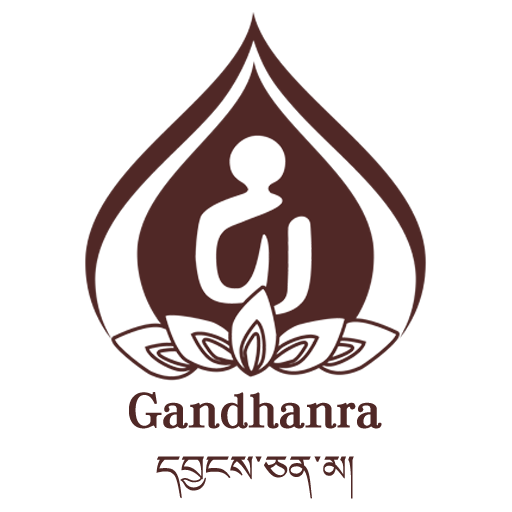

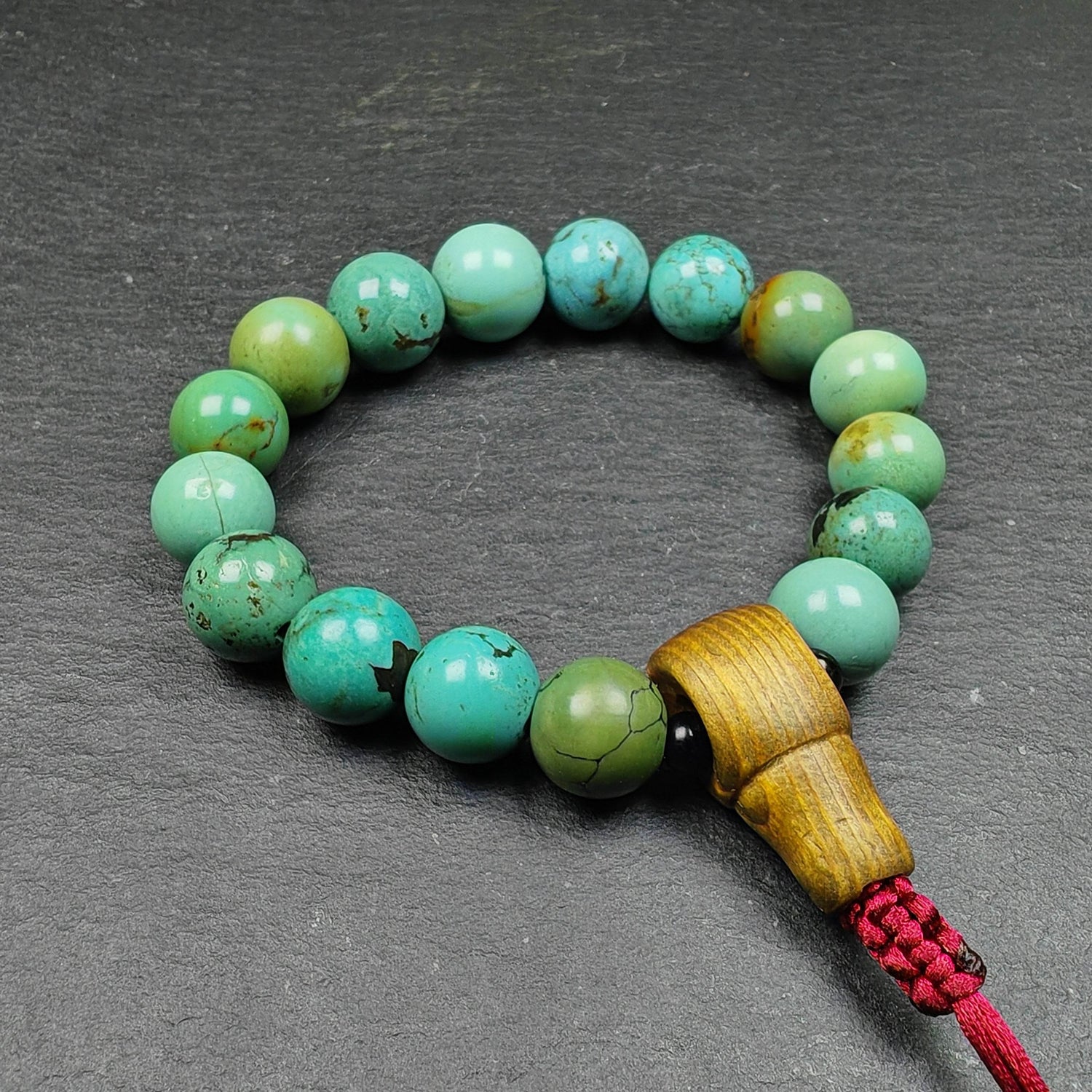
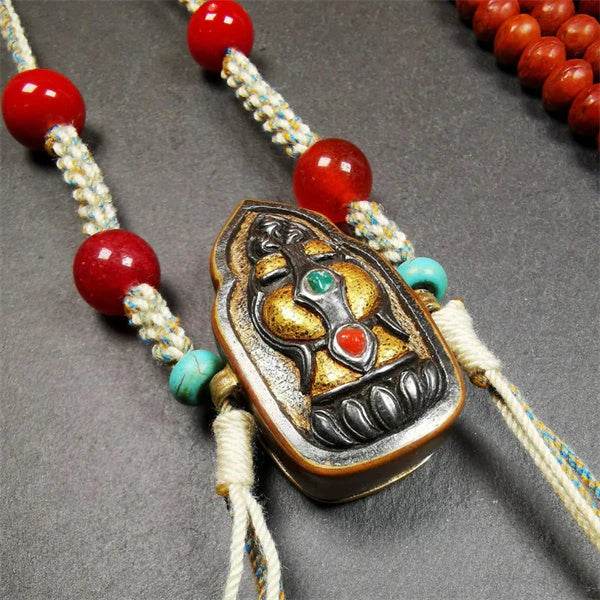

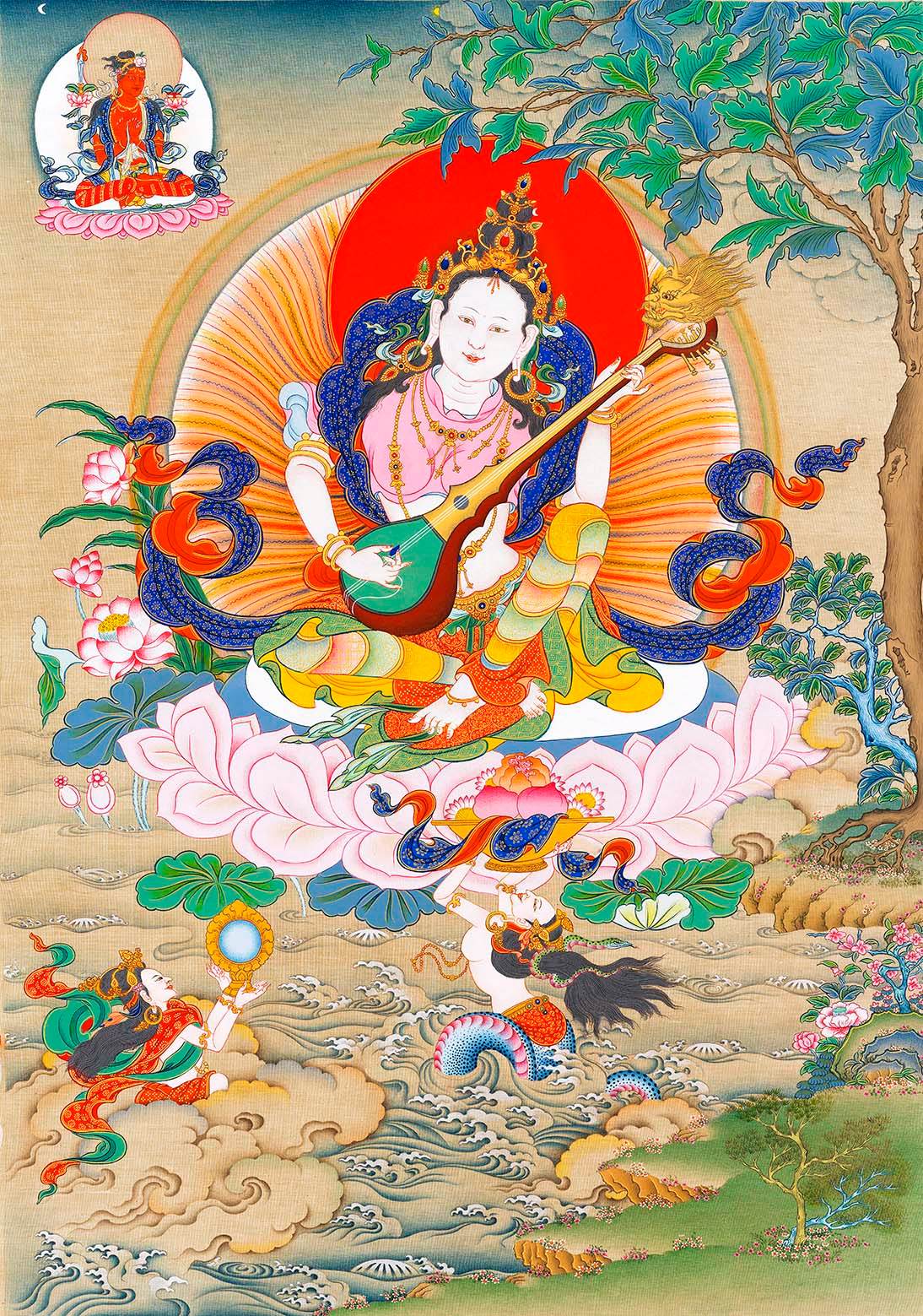

1 commentaire
60gc08